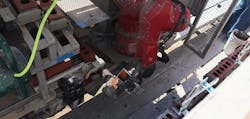Bricklaying robot speeds up construction time of University of Nevada Arts Building
By David Malone, Associate Editor
The University of Nevada’s new Arts Building will require about 100,000 bricks to be installed in the three-story building. But for the first time in Nevada, about 60% of those bricks will be laid by SAM, a bricklaying robot.
SAM, which stands for Semi-Automated Mason, is being used on the $35.5 million project to cut construction time and costs and help with Nevada’s construction labor shortage. The device uses a robotic arm, computer programming, and a materials-feeder system to lay bricks at a rate of about one brick every eight seconds.
The robotic, metal arm spreads mortar on brick and uses a laser-guided system to lay rows. According to Q&D Construction, the project’s general contractor, SAM can accomplish the work of five masons.
See Also: Rovers set to invade construction jobsites
The robot is designed to work on large, uninterrupted walls, which means the first five feet of an area, corners, and around windows must be done by hand by a mason. Additionally, humans are still needed to set up the Hydro-Mobile scaffolding, program the design, load bricks and mortar, align the row, clean the mortar joints, and do the finishing touches to set the brick. Even with all of the human help still needed, SAM sped up the brick veneer installation process by 50%.
When completed, the Arts Building will feature a 287-seat recital hall, a new art museum, a fabrication lab, an electroacoustic lab, soundproof rehearsal spaces, music practice rooms, faculty office spaces, and a recording studio. Construction is slated to complete in the fall with the grand opening held during Spring 2019 semester.
